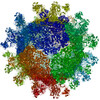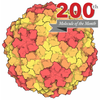+ Open data
Open data
- Basic information
Basic information
| Entry | Database: EMDB / ID: EMD-30408 | |||||||||
|---|---|---|---|---|---|---|---|---|---|---|
| Title | E30 E-particle in complex with 6C5 | |||||||||
 Map data Map data | ||||||||||
 Sample Sample |
| |||||||||
 Keywords Keywords | Echovirus B / mature / VIRUS / neutralizing MAb | |||||||||
| Function / homology |  Function and homology information Function and homology informationsymbiont-mediated suppression of host cytoplasmic pattern recognition receptor signaling pathway via inhibition of RIG-I activity / picornain 2A / symbiont-mediated suppression of host mRNA export from nucleus / symbiont genome entry into host cell via pore formation in plasma membrane / picornain 3C / T=pseudo3 icosahedral viral capsid / host cell cytoplasmic vesicle membrane / nucleoside-triphosphate phosphatase / channel activity / monoatomic ion transmembrane transport ...symbiont-mediated suppression of host cytoplasmic pattern recognition receptor signaling pathway via inhibition of RIG-I activity / picornain 2A / symbiont-mediated suppression of host mRNA export from nucleus / symbiont genome entry into host cell via pore formation in plasma membrane / picornain 3C / T=pseudo3 icosahedral viral capsid / host cell cytoplasmic vesicle membrane / nucleoside-triphosphate phosphatase / channel activity / monoatomic ion transmembrane transport / DNA replication / RNA helicase activity / endocytosis involved in viral entry into host cell / symbiont-mediated activation of host autophagy / RNA-directed RNA polymerase / cysteine-type endopeptidase activity / viral RNA genome replication / RNA-directed RNA polymerase activity / DNA-templated transcription / virion attachment to host cell / host cell nucleus / structural molecule activity / ATP hydrolysis activity / proteolysis / RNA binding / zinc ion binding / ATP binding / membrane Similarity search - Function | |||||||||
| Biological species |  Echovirus E30 / Echovirus E30 /  | |||||||||
| Method | single particle reconstruction / cryo EM / Resolution: 3.4 Å | |||||||||
 Authors Authors | Wang K / Zhu F | |||||||||
| Funding support |  China, 1 items China, 1 items
| |||||||||
 Citation Citation |  Journal: Nat Commun / Year: 2020 Journal: Nat Commun / Year: 2020Title: Serotype specific epitopes identified by neutralizing antibodies underpin immunogenic differences in Enterovirus B. Authors: Kang Wang / Binyang Zheng / Li Zhang / Lunbiao Cui / Xuan Su / Qian Zhang / Zhenxi Guo / Yu Guo / Wei Zhang / Ling Zhu / Fengcai Zhu / Zihe Rao / Xiangxi Wang /  Abstract: Echovirus 30 (E30), a serotype of Enterovirus B (EV-B), recently emerged as a major causative agent of aseptic meningitis worldwide. E30 is particularly devastating in the neonatal population and ...Echovirus 30 (E30), a serotype of Enterovirus B (EV-B), recently emerged as a major causative agent of aseptic meningitis worldwide. E30 is particularly devastating in the neonatal population and currently no vaccine or antiviral therapy is available. Here we characterize two highly potent E30-specific monoclonal antibodies, 6C5 and 4B10, which efficiently block binding of the virus to its attachment receptor CD55 and uncoating receptor FcRn. Combinations of 6C5 and 4B10 augment the sum of their individual anti-viral activities. High-resolution structures of E30-6C5-Fab and E30-4B10-Fab define the location and nature of epitopes targeted by the antibodies. 6C5 and 4B10 engage the capsid loci at the north rim of the canyon and in-canyon, respectively. Notably, these regions exhibit antigenic variability across EV-Bs, highlighting challenges in development of broad-spectrum antibodies. Our structures of these neutralizing antibodies of E30 are instructive for development of vaccines and therapeutics against EV-B infections. | |||||||||
| History |
|
- Structure visualization
Structure visualization
| Movie |
 Movie viewer Movie viewer |
|---|---|
| Structure viewer | EM map:  SurfView SurfView Molmil Molmil Jmol/JSmol Jmol/JSmol |
| Supplemental images |
- Downloads & links
Downloads & links
-EMDB archive
| Map data |  emd_30408.map.gz emd_30408.map.gz | 166.1 MB |  EMDB map data format EMDB map data format | |
|---|---|---|---|---|
| Header (meta data) |  emd-30408-v30.xml emd-30408-v30.xml emd-30408.xml emd-30408.xml | 16.7 KB 16.7 KB | Display Display |  EMDB header EMDB header |
| Images |  emd_30408.png emd_30408.png | 83 KB | ||
| Filedesc metadata |  emd-30408.cif.gz emd-30408.cif.gz | 6.4 KB | ||
| Archive directory |  http://ftp.pdbj.org/pub/emdb/structures/EMD-30408 http://ftp.pdbj.org/pub/emdb/structures/EMD-30408 ftp://ftp.pdbj.org/pub/emdb/structures/EMD-30408 ftp://ftp.pdbj.org/pub/emdb/structures/EMD-30408 | HTTPS FTP |
-Validation report
| Summary document |  emd_30408_validation.pdf.gz emd_30408_validation.pdf.gz | 775.8 KB | Display |  EMDB validaton report EMDB validaton report |
|---|---|---|---|---|
| Full document |  emd_30408_full_validation.pdf.gz emd_30408_full_validation.pdf.gz | 775.4 KB | Display | |
| Data in XML |  emd_30408_validation.xml.gz emd_30408_validation.xml.gz | 6.9 KB | Display | |
| Data in CIF |  emd_30408_validation.cif.gz emd_30408_validation.cif.gz | 8 KB | Display | |
| Arichive directory |  https://ftp.pdbj.org/pub/emdb/validation_reports/EMD-30408 https://ftp.pdbj.org/pub/emdb/validation_reports/EMD-30408 ftp://ftp.pdbj.org/pub/emdb/validation_reports/EMD-30408 ftp://ftp.pdbj.org/pub/emdb/validation_reports/EMD-30408 | HTTPS FTP |
-Related structure data
| Related structure data |  7cmkMC  7c80C  7c81C M: atomic model generated by this map C: citing same article ( |
|---|---|
| Similar structure data |
- Links
Links
| EMDB pages |  EMDB (EBI/PDBe) / EMDB (EBI/PDBe) /  EMDataResource EMDataResource |
|---|---|
| Related items in Molecule of the Month |
- Map
Map
| File |  Download / File: emd_30408.map.gz / Format: CCP4 / Size: 178 MB / Type: IMAGE STORED AS FLOATING POINT NUMBER (4 BYTES) Download / File: emd_30408.map.gz / Format: CCP4 / Size: 178 MB / Type: IMAGE STORED AS FLOATING POINT NUMBER (4 BYTES) | ||||||||||||||||||||||||||||||||||||||||||||||||||||||||||||||||||||
|---|---|---|---|---|---|---|---|---|---|---|---|---|---|---|---|---|---|---|---|---|---|---|---|---|---|---|---|---|---|---|---|---|---|---|---|---|---|---|---|---|---|---|---|---|---|---|---|---|---|---|---|---|---|---|---|---|---|---|---|---|---|---|---|---|---|---|---|---|---|
| Projections & slices | Image control
Images are generated by Spider. | ||||||||||||||||||||||||||||||||||||||||||||||||||||||||||||||||||||
| Voxel size | X=Y=Z: 1.32 Å | ||||||||||||||||||||||||||||||||||||||||||||||||||||||||||||||||||||
| Density |
| ||||||||||||||||||||||||||||||||||||||||||||||||||||||||||||||||||||
| Symmetry | Space group: 1 | ||||||||||||||||||||||||||||||||||||||||||||||||||||||||||||||||||||
| Details | EMDB XML:
CCP4 map header:
| ||||||||||||||||||||||||||||||||||||||||||||||||||||||||||||||||||||
-Supplemental data
- Sample components
Sample components
-Entire : Echovirus E30 in complex with 6C5
| Entire | Name: Echovirus E30 in complex with 6C5 |
|---|---|
| Components |
|
-Supramolecule #1: Echovirus E30 in complex with 6C5
| Supramolecule | Name: Echovirus E30 in complex with 6C5 / type: complex / ID: 1 / Parent: 0 / Macromolecule list: all / Details: The complex is obtained by mixing E30 with 6C5 |
|---|
-Supramolecule #2: E30
| Supramolecule | Name: E30 / type: complex / ID: 2 / Parent: 1 / Macromolecule list: #1-#3 Details: E30 particles purified from the cells inoculated with live E30 |
|---|---|
| Source (natural) | Organism:  Echovirus E30 Echovirus E30 |
-Supramolecule #3: 6C5-Fab
| Supramolecule | Name: 6C5-Fab / type: complex / ID: 3 / Parent: 1 / Macromolecule list: #4-#5 Details: Fab fragment generated by proteolytic cleavage of IgG antibody. |
|---|---|
| Source (natural) | Organism:  |
-Macromolecule #1: VP1
| Macromolecule | Name: VP1 / type: protein_or_peptide / ID: 1 / Number of copies: 1 / Enantiomer: LEVO |
|---|---|
| Source (natural) | Organism:  Echovirus E30 Echovirus E30 |
| Molecular weight | Theoretical: 33.091008 KDa |
| Sequence | String: NDPESALNRA VGRVADTVAS GPVNTEQIPA LTAVETGHTS QVVPSDTMQT RHVINYHTRS ESSIENFMGR AACVYIAQYA TEKVNDELD RYTNWEITTR QVAQLRRKLE MFTYMRFDLE ITFVITSSQR TSTTYASDSP PLTHQVMYVP PGGPIPKSYE D FAWQTSTN ...String: NDPESALNRA VGRVADTVAS GPVNTEQIPA LTAVETGHTS QVVPSDTMQT RHVINYHTRS ESSIENFMGR AACVYIAQYA TEKVNDELD RYTNWEITTR QVAQLRRKLE MFTYMRFDLE ITFVITSSQR TSTTYASDSP PLTHQVMYVP PGGPIPKSYE D FAWQTSTN PSVFWTEGNA PPRMSIPFMS VGNAYCNFYD GWSHFSQSGV YGYTTLNNMG HLYFRHVNKS TAYPVNSVAR VY FKPKHVK AWVPRAPRLC PYLKARNVNF NVQGVTESRN KITLDRSTHN PLANT |
-Macromolecule #2: VP2
| Macromolecule | Name: VP2 / type: protein_or_peptide / ID: 2 / Number of copies: 1 / Enantiomer: LEVO |
|---|---|
| Source (natural) | Organism:  Echovirus E30 Echovirus E30 |
| Molecular weight | Theoretical: 36.428777 KDa |
| Sequence | String: MGAQVSTQKT GAHETGLNAS GNSIIHYTNI NYYKDSASNS LNRQDFTQDP SKFTEPVKDV MIKTLPALNS PTVEECGYSD RVRSITLGN STITTQECAN VVVGYGVWPT YLSDHEATAV DQPTQPDVAT CRFYTLESVK WESSSAGWWW KFPEALSDMG L FGQNMQYH ...String: MGAQVSTQKT GAHETGLNAS GNSIIHYTNI NYYKDSASNS LNRQDFTQDP SKFTEPVKDV MIKTLPALNS PTVEECGYSD RVRSITLGN STITTQECAN VVVGYGVWPT YLSDHEATAV DQPTQPDVAT CRFYTLESVK WESSSAGWWW KFPEALSDMG L FGQNMQYH YLGRTGYTIH VQCNASKFHQ GCLLVVCVPE AEMGAATTDH AFNHTKLSNI GQAMEFSAKK STDQTGPQTA VH NAGMGVA VGNLTIFPHQ WINLRTNNSA TIVMPYINSV PMDNMYRHYN FTLMVIPFAK LEHSPQASTY VPITVTVAPM CAE YNGLRL AGHQ |
-Macromolecule #3: VP3
| Macromolecule | Name: VP3 / type: protein_or_peptide / ID: 3 / Number of copies: 1 / Enantiomer: LEVO |
|---|---|
| Source (natural) | Organism:  Echovirus E30 Echovirus E30 |
| Molecular weight | Theoretical: 26.157531 KDa |
| Sequence | String: GLPTMNTPGS TQFLTSDDFQ SPSAMPQFDV TPEIQIPGQV RNLMEIAEVD SVVPVNNTEG HVNSMEAYRI PVRPQTSSGE QVFGFQLQP GHDSVLKHTL LGEILNYYAN WSGSMKLTFM YCGAAMATGK FLIAYSPPGA GVPGSRRDAM LGTHVIWDVG L QSSCVLCV ...String: GLPTMNTPGS TQFLTSDDFQ SPSAMPQFDV TPEIQIPGQV RNLMEIAEVD SVVPVNNTEG HVNSMEAYRI PVRPQTSSGE QVFGFQLQP GHDSVLKHTL LGEILNYYAN WSGSMKLTFM YCGAAMATGK FLIAYSPPGA GVPGSRRDAM LGTHVIWDVG L QSSCVLCV PWISQTNYRY VTSDAYTDAG YITCWYQTSI VTPPDIPTTS TILCFVSACN DFSVRLLRDT PFITQQALFQ |
-Macromolecule #4: Heavy chain
| Macromolecule | Name: Heavy chain / type: protein_or_peptide / ID: 4 / Number of copies: 1 / Enantiomer: LEVO |
|---|---|
| Source (natural) | Organism:  |
| Molecular weight | Theoretical: 23.332088 KDa |
| Sequence | String: QVQLQQSGSE LVRPGASVKL SCRASGYTFT TYWMHWVKQR PGQGLEWIGN IYPHSGNTNY DERFKSKATL TVDTSSSTAY MQLSSLTSE DSAVYYCTRD LRGFAYWGQG TTVTVSSPKT TPPSVYPLAP AAASTAASMV TLGCLVKGYF PEPVTVTWNS G SLSSGVHT ...String: QVQLQQSGSE LVRPGASVKL SCRASGYTFT TYWMHWVKQR PGQGLEWIGN IYPHSGNTNY DERFKSKATL TVDTSSSTAY MQLSSLTSE DSAVYYCTRD LRGFAYWGQG TTVTVSSPKT TPPSVYPLAP AAASTAASMV TLGCLVKGYF PEPVTVTWNS G SLSSGVHT FPAVLQSDLY TLSSSVTVPS STWPSETVTC NVAHPASSTK VDKKIVPR |
-Macromolecule #5: Light chain
| Macromolecule | Name: Light chain / type: protein_or_peptide / ID: 5 / Number of copies: 1 / Enantiomer: LEVO |
|---|---|
| Source (natural) | Organism:  |
| Molecular weight | Theoretical: 23.490846 KDa |
| Sequence | String: DIELTQSPAI MSASPGEKVT MTCSASSSLR YMHWYQQKSG TSPKRWIYDT YNLASGVPVR FSGSGSGTSY SLTISSMEAE DAATYYCQQ WSSNPPTFGA GTKLELKRAD AAPTVSIFPP SSEQLTSGGA SVVCFLNNFY PKDINVKWKI DGSERQNGVL N SWTDQDSK ...String: DIELTQSPAI MSASPGEKVT MTCSASSSLR YMHWYQQKSG TSPKRWIYDT YNLASGVPVR FSGSGSGTSY SLTISSMEAE DAATYYCQQ WSSNPPTFGA GTKLELKRAD AAPTVSIFPP SSEQLTSGGA SVVCFLNNFY PKDINVKWKI DGSERQNGVL N SWTDQDSK DSTYSMSSTL TLTKDEYERH NSYTCEATHK TSTSPIVKSF NRNEC |
-Experimental details
-Structure determination
| Method | cryo EM |
|---|---|
 Processing Processing | single particle reconstruction |
| Aggregation state | particle |
- Sample preparation
Sample preparation
| Buffer | pH: 7.4 |
|---|---|
| Grid | Model: Quantifoil R1.2/1.3 / Material: GOLD / Mesh: 400 / Support film - Material: CARBON / Support film - topology: HOLEY / Pretreatment - Type: PLASMA CLEANING |
| Vitrification | Cryogen name: ETHANE / Chamber humidity: 100 % / Instrument: FEI VITROBOT MARK I |
- Electron microscopy
Electron microscopy
| Microscope | FEI TITAN KRIOS |
|---|---|
| Image recording | Film or detector model: GATAN K2 SUMMIT (4k x 4k) / Detector mode: SUPER-RESOLUTION / Average electron dose: 30.0 e/Å2 |
| Electron beam | Acceleration voltage: 300 kV / Electron source:  FIELD EMISSION GUN FIELD EMISSION GUN |
| Electron optics | Illumination mode: FLOOD BEAM / Imaging mode: DARK FIELD / Cs: 2.7 mm |
| Sample stage | Specimen holder model: FEI TITAN KRIOS AUTOGRID HOLDER / Cooling holder cryogen: NITROGEN |
| Experimental equipment |  Model: Titan Krios / Image courtesy: FEI Company |
- Image processing
Image processing
| Startup model | Type of model: INSILICO MODEL |
|---|---|
| Final reconstruction | Applied symmetry - Point group: I (icosahedral) / Resolution.type: BY AUTHOR / Resolution: 3.4 Å / Resolution method: FSC 0.143 CUT-OFF / Software - Name: RELION (ver. 3.0) / Number images used: 2120 |
| Initial angle assignment | Type: PROJECTION MATCHING / Software - Name: RELION |
| Final angle assignment | Type: PROJECTION MATCHING / Software - Name: RELION |
-Atomic model buiding 1
| Refinement | Space: REAL / Protocol: RIGID BODY FIT |
|---|---|
| Output model |  PDB-7cmk: |
 Movie
Movie Controller
Controller


















 Z (Sec.)
Z (Sec.) Y (Row.)
Y (Row.) X (Col.)
X (Col.)





















